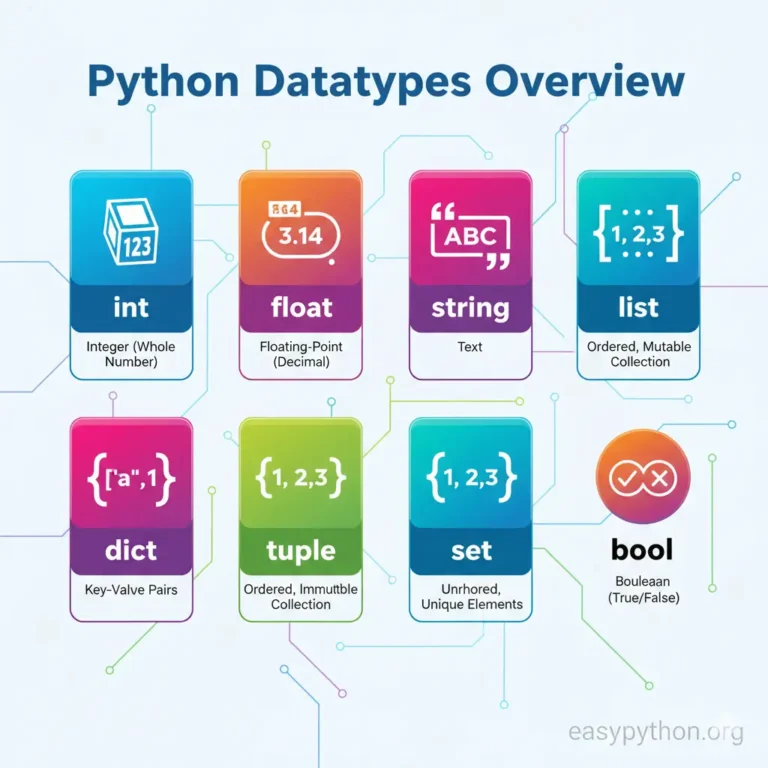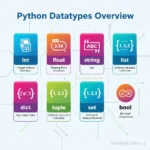Let’s be honest: the first time someone tells you about “datatypes” in Python, your brain does a little Windows XP shutdown sound. 💀 You’re like,
“Why can’t Python just figure it out? Why do I need to care about whether this thing is an int, a str, or some mythical beast called a tuple?”
Well, friend, datatypes aren’t just nerdy trivia. They’re the reason your Python code doesn’t collapse into chaos like your diet plan on the second day of keto. 🥲
So buckle up. By the end of this guide, you’ll not only know what Python datatypes are—you’ll be able to explain them to your cat 🐱 (who still won’t care, but hey, progress).
What Are Python Datatypes?
In plain English: a datatype is just the “type” of value your variable is holding.
Think of Python as a picky waiter. If you order coffee ☕, it brings coffee. If you order pizza 🍕, you get pizza. But if you order “just… food,” Python will look at you like: “Sir, this is a Wendy’s.”
👉 Every value in Python has a type, and knowing these types saves you from errors and existential dread.
If you’re brand new to Python, you might first want to peek at what Python actually is. It’ll make this datatype adventure much less intimidating.
Built-in Python Datatypes
Python comes with a bunch of built-in datatypes. Let’s break them down like a Netflix binge list:
1. Numeric Types
- int → Whole numbers. Example:
42(the meaning of life). - float → Decimal numbers. Example:
3.14(pie, not pi). - complex → Numbers with imaginary parts. Example:
2 + 3j. Yeah, Python supports math you pretended to understand in high school.
age = 25 # int
pi = 3.14159 # float
z = 2 + 3j # complex2. String Type
Strings (str) are just text. Anything inside quotes.
name = "Python"
mood = 'hungry'Pro tip: Strings are like exes—they’re technically immutable. You can’t change them directly; you just make new ones.
If you’re still confused about variables, you’ll love this guide: Python Variables & Assigning Values.
3. Sequence Types
Python’s got three main sequence types:
- list → Ordered, mutable, can hold anything.
shopping = ["eggs", "milk", "Python book"] - tuple → Ordered, but immutable (aka locked).
coordinates = (10.0, 20.0) - range → A range of numbers, usually for loops.
for i in range(5): print(i) # prints 0 to 4
4. Mapping Type
- dict → Your favorite datatype. Key-value pairs.
person = {"name": "Azeem", "age": 25}
It’s like a phonebook, but cooler and without your uncle’s outdated landline.
5. Set Types
- set → Collection of unique items.
- frozenset → Same thing, but immutable.
unique_numbers = {1, 2, 3, 3, 2}
print(unique_numbers) # {1, 2, 3}Great for when you’re tired of duplicates (like spam calls).
6. Boolean Type
- bool →
TrueorFalse
is_python_fun = True
is_java_easier = FalseSpoiler: The second one will spark debates. 🔥
7. Binary Types
- bytes, bytearray, memoryview
Mostly used when working with low-level data like files or images. If you’re a beginner, skip this for now. It’s like the “extended cut” of Python datatypes.
Mutable vs Immutable
Python datatypes fall into two camps:
- Mutable → Can be changed after creation (lists, dicts, sets).
- Immutable → Can’t be changed (int, float, str, tuple).
Think of it as:
- Mutable = your Spotify playlist (you can add/remove songs).
- Immutable = your birthdate (sorry, you’re stuck).
Why Do Python Datatypes Even Matter? 🤔
- Error prevention: Adding a number to a string without conversion? Python will roast you with a
TypeError. - Efficiency: Knowing the right datatype makes your code faster and memory-friendly.
- Clean code: Makes your logic less messy.
If you’ve ever screamed at a “IndentationError”, you know how Python loves rules. (Check this out: Python Indentation Rules).
How to Check Datatypes in Python
Use the type() function:
x = "Hello"
print(type(x)) # <class 'str'>Or go full detective with isinstance():
print(isinstance(42, int)) # TrueType Casting
Sometimes you need to switch datatypes:
x = "100"
y = int(x) # now y is 100 (int, not string)It’s like dressing up a string as a number. Just don’t mix it up too much, or Python will yell at you.
FAQs
How many datatypes are in Python?
A bunch. The main ones are numeric, string, sequence, mapping, set, boolean, binary, and custom classes.
What’s the difference between list and tuple?
List = flexible friend. Tuple = boring but reliable friend.
Can I make my own datatype?
Yep. Define a class, boom—you made a new datatype. Power unlocked.
Final Thoughts
If you’ve made it this far, congrats—you now know more about Python datatypes than 90% of people who claim they “know Python.” 😉
Datatypes aren’t just for geeks; they’re the foundation of writing clean, bug-free code. Next time someone asks you “What is Python?” don’t just say “a programming language.” Tell them it’s a world where even numbers and strings have personalities.
👉 And if you’re just starting out, maybe pair this with our guide on getting started with Python.
Now go forth, and may your TypeErrors be few and your True always logical. ✌️





[…] For more on data types and conversions, check out this handy guide: Python Data Types Overview with Examples. […]
[…] especially useful when learning the basics — like data types or […]
[…] If you’re new to Python, I’d highly recommend peeking at this Python datatypes overview before diving […]
[…] If you’re brand new to Python basics, you might wanna first skim through this Python Data Types overview. Sets are part of that family, right alongside lists, tuples, and […]
[…] If you’re new to Python, check out this Python data types overview first—it’s like a warm-up stretch before lifting heavy coding […]
[…] If you’re still new to Python basics, check out our Python data types overview to see where tuples fit […]
[…] Python data types like strings, numbers, and […]